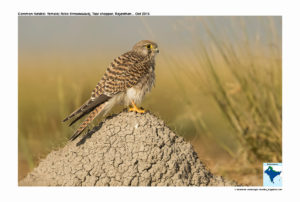Common-kestrel

Common Kestrel Falco tinnunculus
Etymology :
- Falco : Latin for Falcon based on Sickle shaped claws ( falcis- sickle)
- Tinnunculus : Latin Name tinnulus – shrill sounding
Vernacular Names : Hindi: Karontia, Koruttia, Khermutia, Narzinak (M), Narzi (F), Kash: Bohar, Pun: Lal shikra, Lepcha: Ting kyi, Guj: Larji, Moti laraji, Te: Thondala muchi gadda, Thondala doshi gadu, Mal: Cherupullu, Mar: Samanya Kharuchi
Distribution in India: Resident of Himalayas and Western Ghats and widespread Winter Visitor in India.
Description: Size of 27–35 cm; wt. of male 136–252 g, female 154–314 g; wingspan of 57–79 cm.Its Head and tail are grey, with subterminal black band on tail; outer half of upperwing dark; rest of upperwing and back chestnut spotted black; pale underparts also spotted, especially on breast and underwing-coverts. Female generally more uniformly coloured and more heavily spotted, lacking grey areas; barred tail. The juvenile is very similar to female; broader streaks below; cere, legs and feet are paler.
Habitat: It is found in great variety of open or moderately wooded terrains, normally with herbaceous vegetation or low shrubs; grassland, steppe and even sub desert, moorland, cultivation, wetlands with light vegetation; also in villages, towns and even cities, on outskirts and in lightly built up areas. From coast to pastures above treeline in mountains; breeds up to 3300 m elevation and occurs up to 5500 m.
Food Habits: It eats small mammals like voles, mice and shrews; open-area passerines; also lizards and insects like beetles, grasshoppers, locusts, crickets; other invertebrates like. earthworms. Is able to locate prey on basis of UV cues from urine traces. Occasionally feeds on carrion. Normally hunts from rather low flight or from perch, carefully surveying the ground; frequent characteristic hovering flight to detect small mammals and other terrestrial prey. They also prowl a patch of hunting ground in a ground-hugging flight, ambushing prey as they happen across it. Prey taken in air mainly insects. Bill is used to damage central nervous system of rodent prey, and thereby reduce prey movement, rather than to kill prey outright; killing occurs by suffocation from squeezing the feet around prey. Hawks insects in artificial light several hours after sundown.
Breeding Habits: They breed in April-May in India. Typically monogamous; rarely, multiple adults attend same nest. Nest-sites is variable like ledges and holes in rock faces, quarries and buildings, trees, in holes or old nests of other birds, particularly corvids. It lays a clutch of 3–6 eggs, laid at intervals of 2 days. The hatching intervals between first- and last-laid eggs 0–10 days. Replacement laying routinely occurs after nest failure, and true double-brooding occurs .The incubation period is 27–31 days done by female. In first phase of nestling period only male brings food. The chicks are born altricial and fledging period is 27–35 days. The chicks dependent on adults, with most prey provided by male.